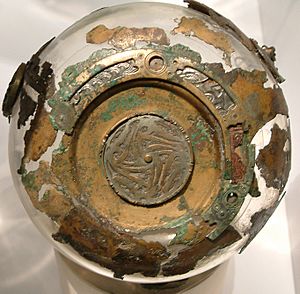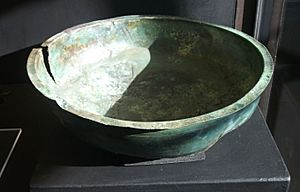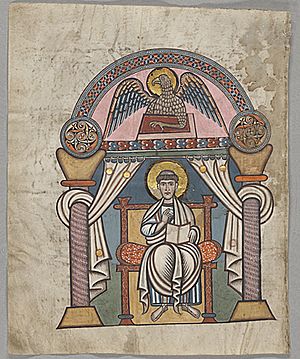Hanging bowl facts for kids



Hanging bowls are unique objects from a period in Britain's history. This time was between the Romans leaving Britain around 410 AD and the rise of Christian Anglo-Saxon kingdoms in the 600s. Most of these bowls have been found in Anglo-Saxon graves. However, many experts agree that their designs show Celtic art styles.
These bowls are usually made of thin, hammered bronze. They are typically 15 to 30 centimeters (6 to 12 inches) wide. Their shape is like a dish or a small pot. They often have three decorated plates, called 'escutcheons', on the outside, just below the rim. These plates hold hooks with rings, which were used to hang the bowls. The designs on these plates are often very detailed. Many include beautiful colored enamel work. This enamel is often made using a method called champlevé, with swirling patterns.
Even though their designs come from Celtic art, most hanging bowls are found in eastern Britain. This is especially true in areas where Anglo-Saxons settled. Anglo-Saxons often buried grave goods with their dead, unlike later Christian customs. These bowls were also made in Pictish and Irish areas. But they are almost never found in the Brittonic parts of Wales, Devon, or Cornwall.
Three hanging bowls were found in the famous Sutton Hoo ship-burial. Another one was found in a different burial mound at the same site. A researcher named Rupert Bruce-Mitford studied 174 finds, which included whole bowls or just parts of them. Most were found in England (117), with some in Ireland (17) and Scotland (7). Others were found in Norway (26), Sweden (2), Denmark (1), Germany (2), Belgium (1), and the Netherlands (1).
What Were They Used For?
The exact use of hanging bowls is still a mystery. Many bowls have fancy escutcheons placed in the center inside. This makes it unlikely they held thick or sticky things, like fat for a lamp. One idea was that they were used as compasses on ships. A magnetic pin would float on water inside the bowl. But this idea is not likely because many bowls have an iron band around the rim. This band would stop a compass from working.
Another idea is that they were used for a Roman custom. This custom involved mixing wine and water to serve at a meal. However, some bowls are too small for serving a large group. But, in special Christian or other religious meals, a group could dip bread into such a wine-bowl. This might have been like the Last Supper.

Part of the puzzle is whether the bowls were hung by strings from a central point, like a lamp. Or, were they hung from hooks on a tripod with tall wooden legs? There is some support for the tripod idea. The closest similar bowls from ancient times are shown with the Oracular Cortina. This was a three-hooked bowl hung inside a tripod. A priestess would sit over it when giving prophecies. If water was in the bowls, it was probably for special religious uses. This could be for baptism or sprinkling, not for everyday drinking. This would be 'special' water, perhaps blessed, or from a holy spring. Tripods are also mentioned as prizes for warriors in old stories, including early Welsh tales.
Designs and Patterns
Some hanging bowls clearly show Christian designs on their escutcheons. The spiral patterns on these bowls changed over time. In the 500s and 600s, a new 'trumpet-spiral' pattern was invented. This pattern was then copied from these enamel bowls. It became part of the designs in famous painted Gospel books. Examples include the Book of Durrow and the Lindisfarne Gospels. These painted designs were meant for quiet thought and religious devotion.
During the Dark Ages, Britain had many different cultures and beliefs. The art, and perhaps some of the uses, of these bowls became part of the Christian art style in Britain. This style mixed Celtic and Anglo-Saxon ideas. One of the best examples is a large bowl from the Sutton Hoo ship-burial, near Woodbridge, Suffolk. It has an enameled fish sculpture inside that can spin on a pin.
Influence on Church Objects
The unique shape of two very famous early Irish chalices is interesting. These are the Ardagh Chalice and the Derrynaflan Chalice. Some people think their shape comes from adapting the hanging bowl form for a different use. Others believe their shapes come from metalwork made in the Byzantine Empire.
See also

